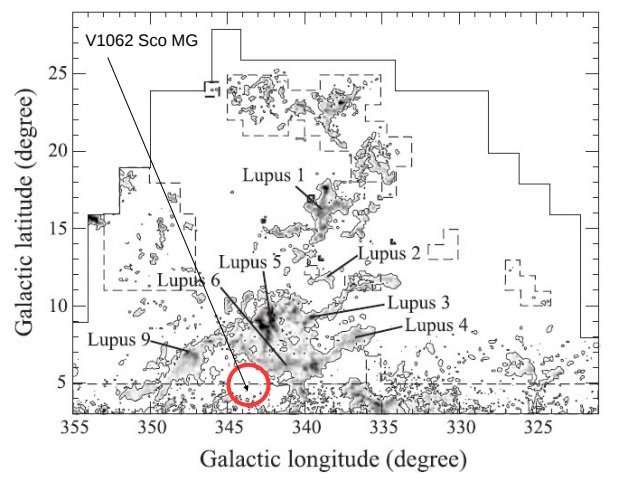January 9, 2018 report
Astronomers discover a new co-moving group of stars

A team of astronomers from Germany and Hungary has detected a new group of co-moving young stars. The newly found group is located in the Upper Centaurus Lupus (UCL) section of the Scorpius–Centaurus Association. The finding is reported in a paper published December 29 on the arXiv pre-print repository.
The Scorpius–Centaurus Association (Sco-Cen) is an association of massive young stars of spectral type O and B. Located at a mean distance of 400 light years away from the Earth, it is the nearest region of recent massive star formation.
One of its subgroups is the UCL, which is almost entirely covered by star-forming regions, except for a small area in the south-eastern corner of this subgroup. Now, a group of researchers led by Siegfried Röser of the Heidelberg University in Germany, has found a compact, young moving group of stars in this particular area of UCL.
The newly detected group, named V1062 Sco Moving Group (V1062 Sco MG for short), was found by analyzing the data available in the Gaia-TGAS proper motion catalog in late 2016. Next, the researchers conducted follow-up observations of V1062 Sco MG using the FEROS instrument at the MPG/ESO 2.2 m Telescope in La Silla, Chile, in order to confirm the discovery and with the aim of determining fundamental parameters of this group.
"We detected a hitherto unknown moving group or cluster in the Upper Centaurus Lupus section of the Sco-Cen OB-association," the scientists wrote in the paper.
According to the study, V1062 Sco MG is a co-moving group of 63 young stars at the edge of the UCL section, some 570 light years away from the Earth.
"Altogether, we found 12 members with confirmed radial velocities and parallaxes, 31 with parallaxes or radial velocities, and 20 candidates from the convergent point method," the paper reads.
However, although the stars of this group are generally young, they are not coeval, as their ages range from four to 25 million years. At the moment, the researchers cannot explain this age spread.
The authors of the paper emphasized that the newly found group is strongly co-moving and its one-dimensional velocity dispersion is less than 1.0 km/s. When it comes to the masses of the members of the group, they range from 0.7 to 2.6 solar masses.
Although the researchers identified dozens of members of V1062 Sco MG, still many stars of this group remain undetected. The authors of the study believe that the Gaia Data Release 2 (from ESA's Gaia satellite), expected to be published in April 2018, will reveal new and fainter members of the group. Further studies of V1062 Sco MG and other co-moving groups could provide important information about the process of star formation in associations.
More information: A new compact young moving group around V1062 Sco, arXiv:1712.10143 [astro-ph.SR] arxiv.org/abs/1712.10143
Abstract
Aims. We are searching for new open clusters or moving groups in the Solar neighbourhood. Methods. We used the Gaia-TGAS catalogue, cut it into narrow proper motion and parallax slices and searched for significant spatial over-densities of stars in each slice. We then examined stars forming over-densities in optical and near-infrared colour-magnitude diagrams to determine if they are compatible with isochrones of a cluster. Results. We detected a hitherto unknown moving group or cluster in the Upper Centaurus Lupus (UCL) section of the Sco-Cen OB-association at a distance of 175 pc from the Sun. It is a group of 63 co-moving stars with ages of less than 10 to about 25 Myr. For the brightest stars, which are present in the Gaia-TGAS catalogue the mean difference between kinematic and trigonometric distance moduli is about 0:01 mag with a standard deviation of 0.11 mag. Fainter cluster candidates are found in the HSOY catalog, where no trigonometric parallaxes are available. For a subset of our candidate stars, we obtained radial velocity measurements at the MPG/ESO 2.2-metre telescope in La Silla. Altogether we found twelve members with confirmed radial velocities and parallaxes, 31 with parallaxes or radial velocities, and 20 candidates from the convergent point method. The isochrone masses of our 63 members range from 2.6 M_Sun to 0.7 M_Sun.
© 2018 Phys.org




















